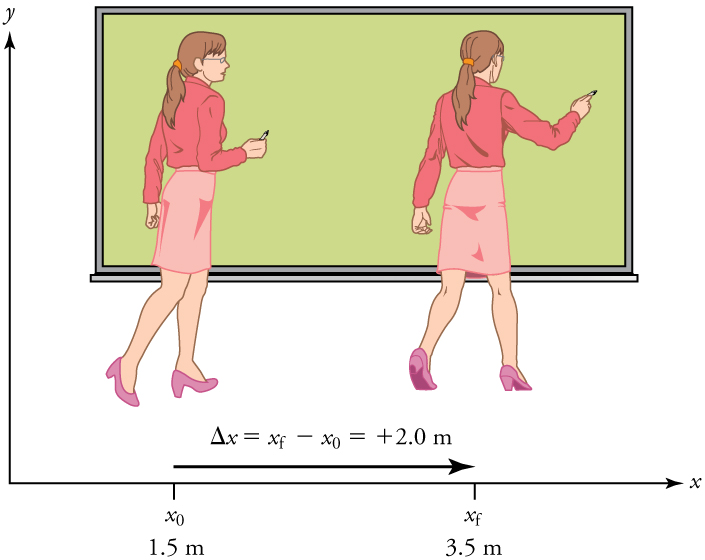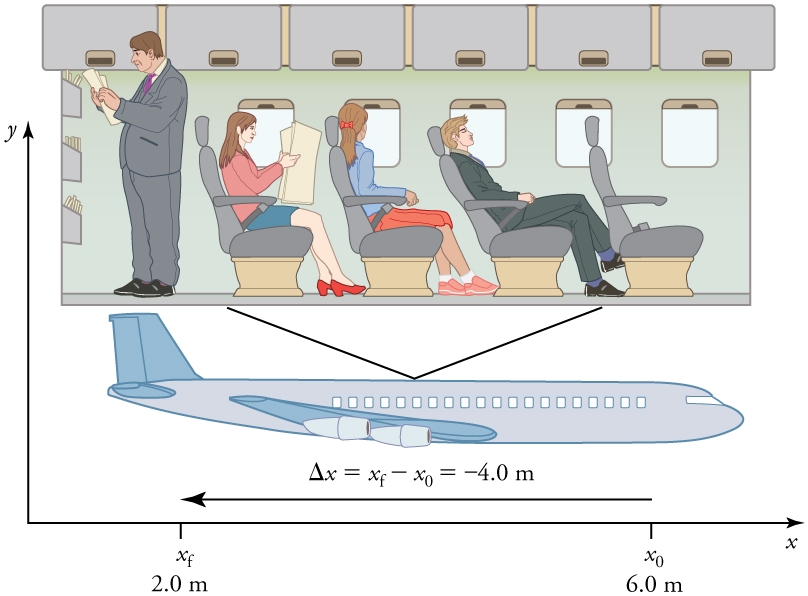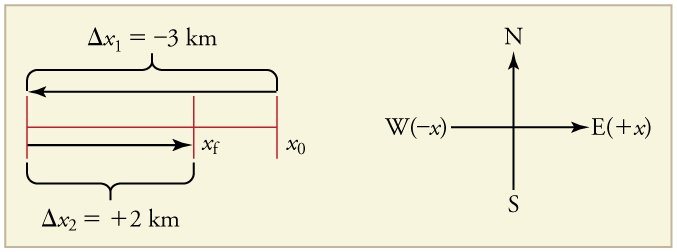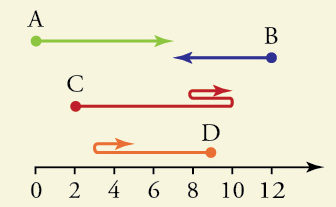18 3.1 Displacement

Position
In order to describe the motion of an object or body, you must first be able to describe its position—where it is at any particular time. More precisely, you need to specify its position relative to a convenient reference frame. Earth is often used as a reference frame, and we often describe the position of an object as it relates to stationary objects in that reference frame. For example, a high jump would be described in terms of the position of the jumper with respect to the Earth as a whole, while a professor’s position could be described in terms of where she is in relation to the nearby white board. In other cases, we use reference frames that are not stationary but are in motion relative to the Earth. To describe the position of a person in an airplane, for example, we use the airplane, not the Earth, as the reference frame. In biomechanics, we typically agree on a reference frame relative to an origin. If we are describing motion based off a picture or video, we use the bottom left-hand corner as our origin and describe movement relative to that point.Please see the figures 2 and 3 below.
Displacement
If an object moves relative to a reference frame (for example, if a professor moves to the right relative to a white board or a passenger moves toward the rear of an airplane), then the object’s position changes. This change in position is known as displacement. The word “displacement” implies that an object has moved, or has been displaced.
DISPLACEMENT
Displacement is the change in position of an object:
where Δp is displacement, pf is the final position (f), and pi is the initial position (i).
In this text the upper case Greek letter Δ (delta) always means “change in” whatever quantity follows it; thus, [latex]\Delta\overrightarrow{\mathbf{p}}[/latex] means change in position. Always solve for displacement by subtracting initial position ([latex]\overrightarrow{\mathbf{p_i}}[/latex]) from final position ([latex]\overrightarrow{\mathbf{p_f}}[/latex]).
Note that the standard unit for displacement is the meter (m), but sometimes kilometers, miles, feet, and other units of length are used. Keep in mind that when units other than the meter are used in a problem, you may need to convert them into meters to complete the calculation.


Note that displacement has a direction as well as a magnitude. The professor’s displacement is 2.0 m to the right, and the airline passenger’s displacement is 4.0 m toward the rear. In one-dimensional motion, direction can be specified with a plus or minus sign. When you begin a problem, you should select which direction is positive (usually that will be to the right or up, but you are free to select positive as being any direction). The professor’s initial position is pxi = 1.5 m and her final position is pxf = 3.5 m. Thus her horizontal displacement is
In this coordinate system, motion to the right is positive, whereas motion to the left is negative. Similarly, the airplane passenger’s initial position is pxi = 6.0 m and his final position is pxf = 2.0 m, so his displacement is
[latex]\Delta\overrightarrow{\mathbf{p_x}} = \overrightarrow{\mathbf{p_{xf}}} - \overrightarrow{\mathbf{p_{xi}}} = 2.0 \textbf{ m} - 6.0 \textbf{ m} = -4.0 \textbf{ m}[/latex]
His displacement is negative because his motion is toward the rear of the plane, or in the negative x direction in our coordinate system.
Note that movement in the vertical direction (up and down) would by specified with a ‘y’ instead of an ‘x’. For example, if a jump moves from 0 m to 0.35 m, her displacement would be calculated as follows:
[latex]\Delta\overrightarrow{\mathbf{p_y}} = \overrightarrow{\mathbf{p_{yf}}} - \overrightarrow{\mathbf{p_{yi}}} = 0.35 \textbf{ m} - 0 \textbf{ m} = 0.35 \textbf{ m or } 35 \textbf{ cm}[/latex]
More details on the symbols ‘x’ for horizontal movements and ‘y’ for vertical movements will be provided in the next section when we introduce coordinate systems.
Distance
Although displacement is described in terms of direction, distance is not. Distance is defined to be the magnitude or size of displacement between two positions. Note that the distance between two positions is not the same as the distance traveled between them. Distance traveled is the total length of the path traveled between two positions. Distance has no direction and, thus, no sign. For example, the distance the professor walks is 2.0 m. The distance the airplane passenger walks is 4.0 m.
MISCONCEPTION ALERT: DISTANCE TRAVELED VS. MAGNITUDE OF DISPLACEMENT
It is important to note that the distance traveled, however, can be greater than the magnitude of the displacement (by magnitude, we mean just the size of the displacement without regard to its direction; that is, just a number with a unit). For example, the professor could pace back and forth many times, perhaps walking a distance of 150 m during a lecture, yet still end up only 2.0 m to the right of her starting point. In this case her displacement would be +2.0 m, the magnitude of her displacement would be 2.0 m, but the distance she traveled would be 150 m. In kinematics we nearly always deal with displacement and magnitude of displacement, and almost never with distance traveled. One way to think about this is to assume you marked the start of the motion and the end of the motion. The displacement is simply the difference in the position of the two marks and is independent of the path taken in traveling between the two marks. The distance traveled, however, is the total length of the path taken between the two marks.
Check Your Understanding 1
1: A cyclist rides 3 km west and then turns around and rides 2 km east. (a) What is her displacement? (b) What distance does she ride? (c) What is the magnitude of her displacement?
Section Summary
- Kinematics is the study of motion without considering its causes. In this chapter, it is limited to motion along a straight line, called one-dimensional motion.
- Displacement is the change in position of an object.
- In symbols, displacement [latex]\Delta\overrightarrow{\mathbf{p}}[/latex] is defined to be
where [latex]\overrightarrow{\mathbf{p_i}}[/latex] is the initial position and [latex]\overrightarrow{\mathbf{p_f}}[/latex] is the final position. In this text, the Greek letter Δ (delta) always means “change in” what ever quantity follows it. The SI unit for displacement is the meter (m). Displacement has a direction as well as a magnitude.
If you are describing movement along the horizontal axis (left to right or right to left) you can express the equation relative to the ‘x’ axis:
[latex]\Delta\overrightarrow{\mathbf{p}} = \overrightarrow{\mathbf{p_{xf}}} - \overrightarrow{\mathbf{p_{xi}}}[/latex]
If you are describing movement along the vertical axis (up and down, down and up) you can express the equation relative to the ‘y’ axis:
[latex]\Delta\overrightarrow{\mathbf{p}} = \overrightarrow{\mathbf{p_{yf}}} - \overrightarrow{\mathbf{p_{yi}}}[/latex]
- When you start a problem, assign which direction will be positive (typically ‘right’ or ‘up’).
- Distance is the length of the path travelled
- Displacement is the difference between the final position and the initial position.
Problems & Exercises
2: Find the following for path B: (a) The distance traveled. (b) The magnitude of the displacement from start to finish. (c) The displacement from start to finish.
3: Find the following for path C: (a) The distance traveled. (b) The magnitude of the displacement from start to finish. (c) The displacement from start to finish.
4: Find the following for path D: (a) The distance traveled. (b) The magnitude of the displacement from start to finish. (c) The displacement from start to finish.
Glossary
- kinematics
- the study of motion without considering its causes
- position
- the location of an object at a particular time
- displacement
- the change in position of an object
- distance
- the magnitude of displacement between two positions
- distance traveled
- the total length of the path traveled between two positions
Solutions
Check Your Understanding 1

1: (a) The rider’s displacement is [latex]\Delta\overrightarrow{\mathbf{p}} = \overrightarrow{\mathbf{p_{xf}}} - \overrightarrow{\mathbf{p_{xi}}}[/latex]. The displacement is negative because we take east to be positive and west to be negative. Or you could just say “1 km to the West”. Note that the drawing clearly showed that West was chosen to be negative. (b) The distance traveled is 3 km + 2 km = 5 km. (c) The magnitude of the displacement is 1 km.
Problems & Exercises
1: (a) 7 m (b) 7 m (c) + 7 m
2: (a) 5 m (b) 5 m (c) – 5 m
3: This is badly drawn so the answers are debatable. Assuming it went from a position of 2 m to 10 then back to 8 and then back again to 10 m that gives a) distance of 12 m b) magnitude of the displacement as 8 m and c) a displacement of +8 m or 8 metres ot the right.
4: (a) 8 m (b) 4 m (c) – 4 m


